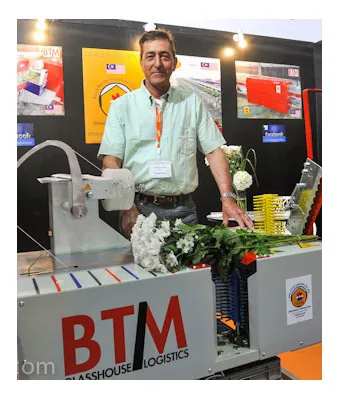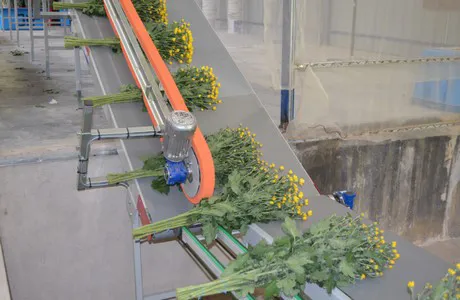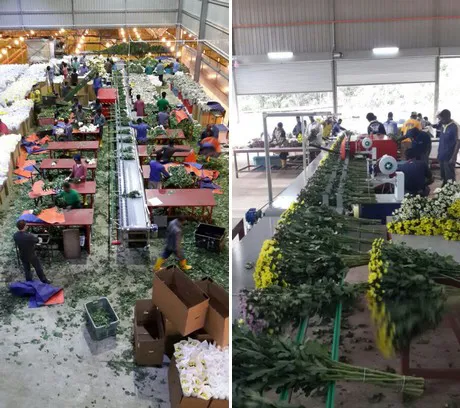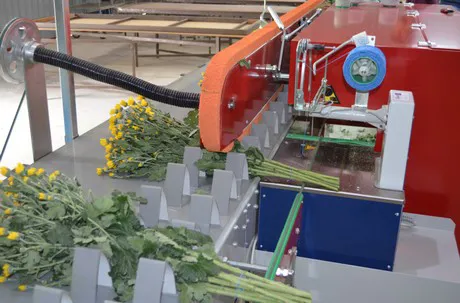 Malaysia currently has around of 15,000 hectares of horticultural production, mainly concentrated in the Cameron Highlands. Of this 15,000 hectares, 8,000 hectares is used for greenhouse production of flowers and vegetables. With an annual export of 600 million stems a year, Malaysia has become the largest supplier of cut chrysanthemums to Japan, Hong Kong, Singapore, Thailand and Australia. According to Baggermans, the growers want to optimize not only their labour, but also the logistical efficiency at the nurseries.
Malaysia currently has around of 15,000 hectares of horticultural production, mainly concentrated in the Cameron Highlands. Of this 15,000 hectares, 8,000 hectares is used for greenhouse production of flowers and vegetables. With an annual export of 600 million stems a year, Malaysia has become the largest supplier of cut chrysanthemums to Japan, Hong Kong, Singapore, Thailand and Australia. According to Baggermans, the growers want to optimize not only their labour, but also the logistical efficiency at the nurseries. The cost of staff is increasing, which is a reason to automate sorting and packing processes. But many growers also faced quality problems due to inefficient logistical processes; the flowers can not stand high temperatures after they have been harvested, and growers realize they need to speed up their sorting and packing processes to maintain a high quality product.

In order to help the Malaysian farmers with their logistical processes, BTM works together with local greenhouse supplier Greenhouse Solutions Asia. "We started three years ago with the first automated processing lines for Malaysian chrysanthemum growers", said Baggermans. "Since then, many growers learned that they could improve their efficiency by making an investment in a flower processing line. Some were able to reduce their labour costs that much, that they earned back the investment in 9 months."
To give an idea how the processes are automated, Baggermans explained a standard flower processing line. "Without automation, all the workers start harvesting in the morning, place the harvest on carts in the warehouse and start sorting, processing and packing the product in the afternoon, sometimes till late at night. Our customer specific automated processing lines allow them to process a lot of stems with less workers. They can streamline their processes and complete batches and orders much easier and faster, with less labour and quality issues as a result. A grower can now calculate his production precisely, because he knows how much he can process per hour."

The processing line is built up from a central conveyor belt on which the workers place the bunches of flowers. The lines are designed according to the desired stem length, which can be adjusted according to the needs of the customer. After the stems are placed on the line, they are transported to an automated module that de-leafs the stems and cuts them at the desired length. At a later station, automated Cyklop bunching machines place one or more elastic cords around the bunch. All of the remaining materials (residual parts of the cut stems and leafs) are collected to a central waste container with a secondary conveyor belt.
The bunched, de-leafed and cut stems are transported to the packing section where they can be sleeved or put into boxes before they go to the cold store.

BTM designs the lines for both large and small growers. According to Frank Hermans of Greenhouse Solutions Asia, even the smaller growers achieve great results with it. "They were surprised how much more efficiency was implemented in the business. They save not only a lot of labour but also time. Workers are only needed to place bunches from the carts to the lines, they no longer have to open bunches, de-leaf them and cut them to the right size. The same workers that have been harvesting in the morning can easily make a batch ready for shipment, That is why the farms can optimize the labour quite easy and earn back the investment of a machine in a relatively short time."
The BTM processing lines are designed and manufactured in Holland. Everything is made according to the needs of the Malaysian growers. Greenhouse Solutions Asia handles all the installations and service in Malaysia.
 For more information:
For more information: BTM Glasshouse Logistics
Gerard Baggermans
+31 (0)497 556226
gbaggermans@btm-bv.nl
www.btm-bv.nl
 Greenhouse Solutions Asia
Greenhouse Solutions AsiaLuuk Runia
72B Persiaran Camellia 4,
39000 Tanah Rata,
Cameron Highlands,
Pahang, Malaysia
info@ghsasia.info
www.ghsasia.info
